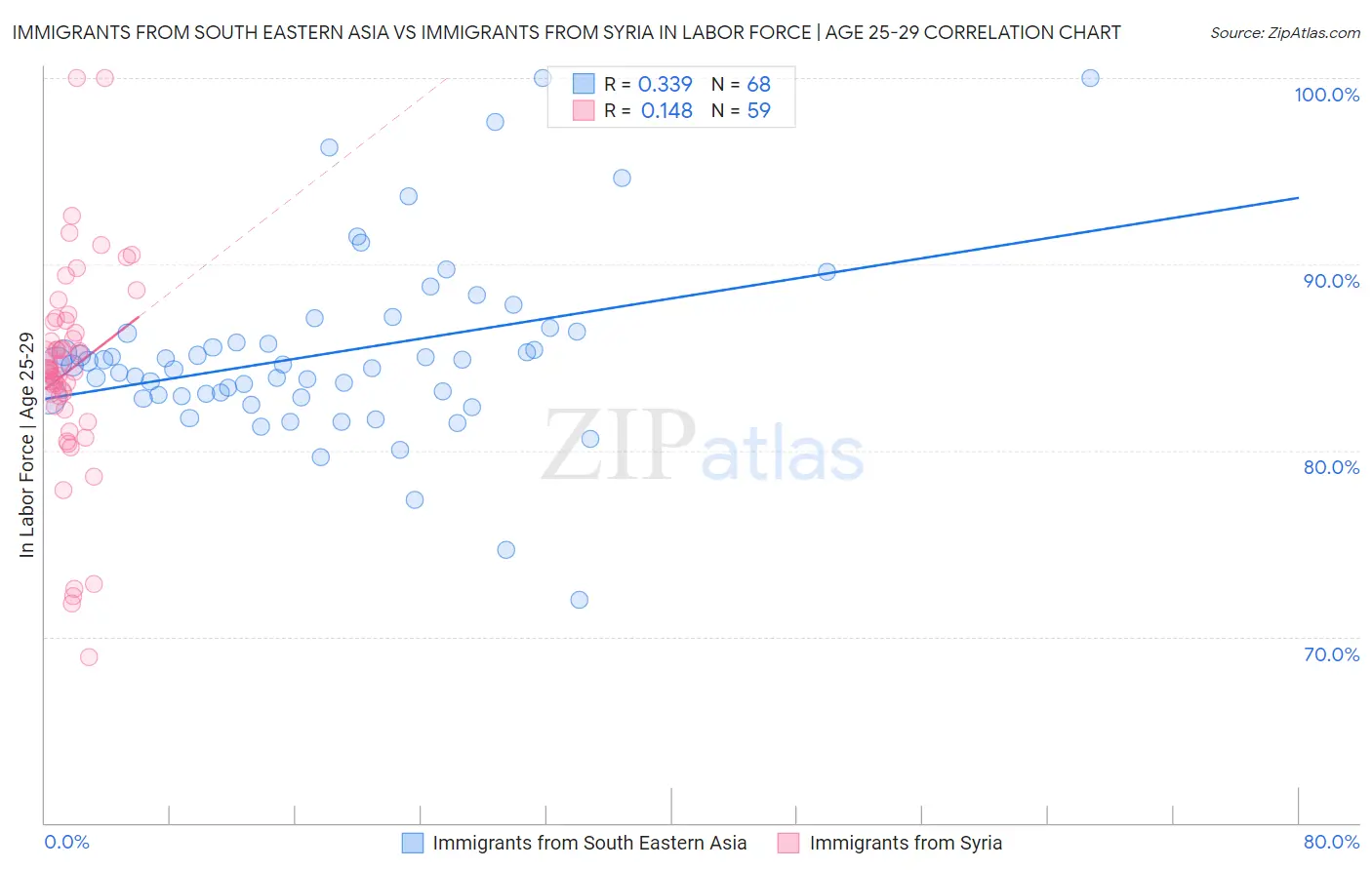Immigrants from South Eastern Asia vs Immigrants from Syria In Labor Force | Age 25-29
COMPARE
Immigrants from South Eastern Asia
Immigrants from Syria
In Labor Force | Age 25-29
In Labor Force | Age 25-29 Comparison
Immigrants from South Eastern Asia
Immigrants from Syria
84.4%
IN LABOR FORCE | AGE 25-29
19.5/ 100
METRIC RATING
196th/ 347
METRIC RANK
84.3%
IN LABOR FORCE | AGE 25-29
10.7/ 100
METRIC RATING
215th/ 347
METRIC RANK
Immigrants from South Eastern Asia vs Immigrants from Syria In Labor Force | Age 25-29 Correlation Chart
The statistical analysis conducted on geographies consisting of 512,343,229 people shows a mild positive correlation between the proportion of Immigrants from South Eastern Asia and labor force participation rate among population between the ages 25 and 29 in the United States with a correlation coefficient (R) of 0.339 and weighted average of 84.4%. Similarly, the statistical analysis conducted on geographies consisting of 174,092,146 people shows a poor positive correlation between the proportion of Immigrants from Syria and labor force participation rate among population between the ages 25 and 29 in the United States with a correlation coefficient (R) of 0.148 and weighted average of 84.3%, a difference of 0.13%.

In Labor Force | Age 25-29 Correlation Summary
| Measurement | Immigrants from South Eastern Asia | Immigrants from Syria |
| Minimum | 72.0% | 68.9% |
| Maximum | 100.0% | 100.0% |
| Range | 28.0% | 31.1% |
| Mean | 85.2% | 84.3% |
| Median | 84.6% | 84.4% |
| Interquartile 25% (IQ1) | 82.9% | 82.4% |
| Interquartile 75% (IQ3) | 86.3% | 86.9% |
| Interquartile Range (IQR) | 3.4% | 4.6% |
| Standard Deviation (Sample) | 4.9% | 5.7% |
| Standard Deviation (Population) | 4.9% | 5.6% |
Demographics Similar to Immigrants from South Eastern Asia and Immigrants from Syria by In Labor Force | Age 25-29
In terms of in labor force | age 25-29, the demographic groups most similar to Immigrants from South Eastern Asia are Tlingit-Haida (84.4%, a difference of 0.0%), Immigrants from Israel (84.4%, a difference of 0.010%), Immigrants from Iraq (84.4%, a difference of 0.010%), Immigrants from Germany (84.4%, a difference of 0.010%), and Immigrants from Kazakhstan (84.4%, a difference of 0.030%). Similarly, the demographic groups most similar to Immigrants from Syria are Japanese (84.3%, a difference of 0.010%), Lebanese (84.3%, a difference of 0.010%), Subsaharan African (84.3%, a difference of 0.020%), Chinese (84.3%, a difference of 0.030%), and Immigrants from Venezuela (84.3%, a difference of 0.030%).
| Demographics | Rating | Rank | In Labor Force | Age 25-29 |
| Immigrants | Israel | 20.8 /100 | #195 | Fair 84.4% |
| Immigrants | South Eastern Asia | 19.5 /100 | #196 | Poor 84.4% |
| Tlingit-Haida | 19.3 /100 | #197 | Poor 84.4% |
| Immigrants | Iraq | 19.0 /100 | #198 | Poor 84.4% |
| Immigrants | Germany | 18.3 /100 | #199 | Poor 84.4% |
| Immigrants | Kazakhstan | 17.5 /100 | #200 | Poor 84.4% |
| Laotians | 16.6 /100 | #201 | Poor 84.4% |
| Afghans | 15.9 /100 | #202 | Poor 84.4% |
| Immigrants | Afghanistan | 15.6 /100 | #203 | Poor 84.4% |
| Venezuelans | 15.1 /100 | #204 | Poor 84.4% |
| Ecuadorians | 14.8 /100 | #205 | Poor 84.4% |
| Immigrants | Cambodia | 14.3 /100 | #206 | Poor 84.4% |
| Immigrants | Armenia | 13.3 /100 | #207 | Poor 84.4% |
| Immigrants | Indonesia | 13.2 /100 | #208 | Poor 84.4% |
| Immigrants | Jordan | 12.8 /100 | #209 | Poor 84.4% |
| Chinese | 12.7 /100 | #210 | Poor 84.3% |
| Immigrants | Venezuela | 12.6 /100 | #211 | Poor 84.3% |
| Sub-Saharan Africans | 11.7 /100 | #212 | Poor 84.3% |
| Japanese | 11.4 /100 | #213 | Poor 84.3% |
| Lebanese | 11.1 /100 | #214 | Poor 84.3% |
| Immigrants | Syria | 10.7 /100 | #215 | Poor 84.3% |